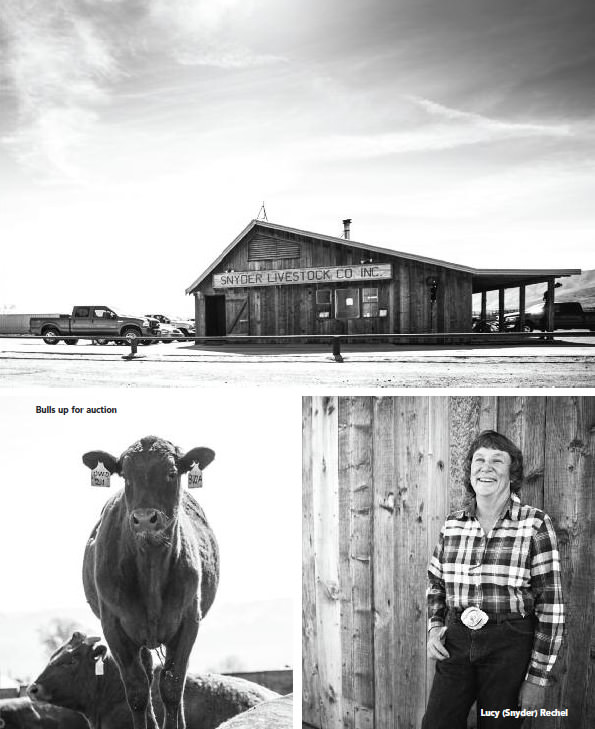meet the farmer
OF BULLS AND BULBS
The Snyders balance two operations at their Yerington ranch.
WRITTEN BY SUSAN DITZ
PHOTOS BY JEN BRITTON
Members of the Snyder family have been farming and ranching along the Walker River in Nevada’s fertile Mason Valley since 1862. The fifth generation of this close-knit Yerington family is 10 strong, with sister Lucy Rechel running the Snyder Livestock Co., a large custom-feeding operation for prime breeding stock. Eldest brother Jim oversees crop production that includes 400 acres of onion varieties, as well as garlic, alfalfa, oat hay, and a new venture that will grow fruits and other vegetables for local markets. Brother John serves as the in-house IT expert, the guy tasked with maintaining all the critical computer hardware and software systems that do everything from controlling irrigation to measuring and tracking the daily feed consumption of thousands of cattle.
At 89 years young, their father, Eddie Snyder (whose great-grandfather Charles came to the valley from Pennsylvania 153 years ago), still keeps his eye on ranch operations from his office near the bull pens.

No-bull business
With their cattle operation, the Snyders handle up to 6,000 heads of bulls and heifers with a humane, low-stress philosophy. And everyone working with the livestock has been Beef Quality Assurance trained and certified, Lucy says. That means the cattle are raised under strong guidelines that blend good science with agricultural best practices, effective record keeping, and protection of herd health to enable “optimal management and environmental conditions.”
 Pens of young bulls lying in the sunshine, relaxed and chewing their cud, illustrate Lucy’s explanation that “everything we do is aimed at producing healthier, happier cattle for our customers and the consumer.”
Pens of young bulls lying in the sunshine, relaxed and chewing their cud, illustrate Lucy’s explanation that “everything we do is aimed at producing healthier, happier cattle for our customers and the consumer.”
This includes working with a professional bovine nutritionist who determines the rations necessary for each animal to achieve the most desirable, balanced weight/muscle. Those ration mixes may contain high-fiber grasses, hay, and a variety of grains, including oats and corn. However, she adds, “even grain-fed cattle spend about 60 percent of their lives on grass.”
Starting in 2006, Lucy says, they instituted a practice in which every step in the process is carefully managed for each animal using electronic ear ID tags and sophisticated computer monitoring. An electronic feed-measurement system can track the consumption of each individual animal “to the mouthful,” and weight is regularly evaluated to identify feed efficiency numbers and test bloodlines for maximum growth.
Lucy and her family believe that their custom-feeding program is optimal and the most economically sound method to meet the ongoing demand for beef, especially at a time when access to water and grasslands is diminishing.
“Cattle grow more slowly on grass, and the method is mostly suitable for expensive niche markets,” she says. “Americans love the taste of grain-fed beef, which is why the demand is so high — the fat makes it more flavorful and juicier. What we’re producing is totally wholesome, totally healthy, and totally safe.”
Diversified crops
Like many other farmers, Jim Snyder has been challenged by the ongoing drought.
“We had to cut back on planting our alfalfa fields to conserve water for the onions,” he says.
Those 400 acres yielded almost 15,000 tons of high-quality onions in the last harvest.
To maximize the water, he says, “We have a dual-irrigation system with overhead and drip on the onions, so we can stretch the water a long way.”
Although they are not organic growers, Jim says they are “certainly very environmentally conscious.”
He explains that the family utilizes technology to reduce its carbon footprint in every aspect of the farming and ranching businesses.
An engineer by training, Jim is an innovator who always is looking for new ways to “feed more people on less land, by making the best use of resources.”
To that end, he decided to branch out by starting a new enterprise, Snyder Family Farms, a boutique operation in which he’ll be growing crops such as arugula, broccoli, peas, and cauliflower in hoop houses he designed and built. Able to extend the growing season, the 40-foot units maintain steady temperatures, feature sidewalls that can be raised and lowered with a simple hand crank, and can be easily moved wherever needed.
In this new cultivation field, he also will be able to grow berries, melons, corn, and squash, all of which will be sold directly to consumers looking for local produce at nearby farmers’ markets. As an added bonus, Jim is enthusiastic that his brother Dave’s wife, Jennifer, will represent the family at the markets.
Keeping the family close and supporting each other seems to be the Snyders’ key to success and sustainability.
Minden resident Susan Ditz was the founding managing editor of edible Silicon Valley and formerly a columnist for the San Jose Mercury News. Her family began ranching in California about the same time the Snyders came to Nevada.
For details about the Snyder ranch, visit http://slcnv.com


